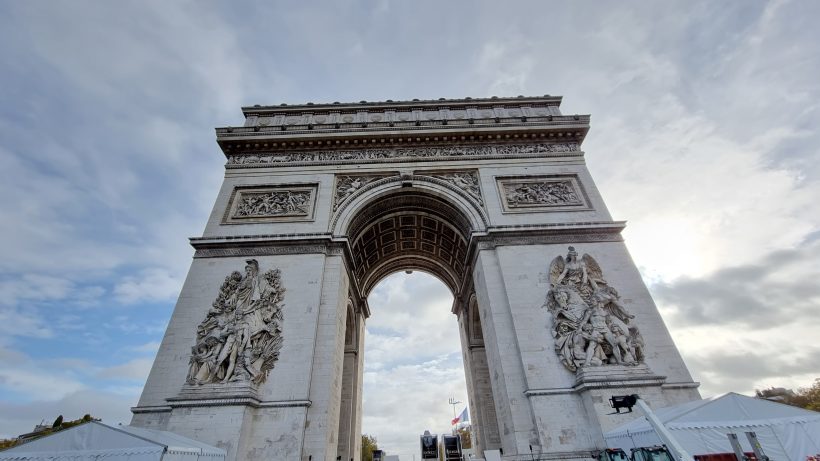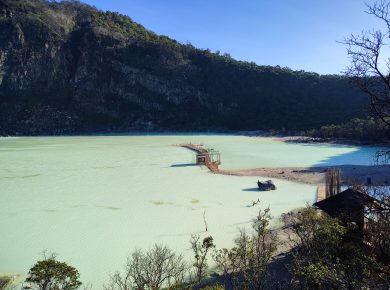Among the places to visit in France, Paris is a gem. Let our travel guide be your compass, leading you to the city’s finest landmarks, museums, and cultural experiences. Discover the essence of the Parisian lifestyle and gain invaluable insights for an exceptional getaway.
Contents
How Paris welcomed us
For my husband and me, Paris did not start with croissants, but with a classic French restaurant. All because we arrived in the capital of France in the evening and decided to start with a romantic dinner. After all, everyone associates Paris with romance, doesn’t it?
We were served a hefty steak and a Lyonnaise salad for dinner. And, of course, wine: you can’t do without it in this city. The restaurant is not cheap (it costs €70 for dinner), but if you want something truly traditional, you can take it on a note: Aux Crus de Bourgogne.
Having had an excellent dinner, we continued our acquaintance with evening Paris: we went for a leisurely walk along its streets.
Already in the first evening, we noticed that the French were sitting on the terraces of cafés and restaurants scattered around the city (despite the coolness) and talking loudly: as it turned out, talking over a glass of wine is a common practice for them. And in general, you get the impression that everyone here has known each other for a very long time.
And then we jumped into the Paris metro: the oldest in Europe after London (we learned about it a little later). We traveled on it for the whole 3.5 days of our trip.
The locals, by the way, also love the metro and constantly move from point to point on it: it’s convenient, as the entrance to the subway is every 2–3 blocks. We also noticed that a lot of Parisians ride bicycles around the city: it’s not on the scale of Amsterdam, of course, but it’s still impressive.
Inside the subway trains, you can see that in Paris live people who know a lot about fashion: almost every passenger can be called a stylist. But it should be noted that it’s about style with some carelessness as if they dressed like this and found this combination of colors by accident: that’s the trick and charm of fashionable Parisians.
Since I’ve started sharing my observations, here are a couple more. People say that the English language in Paris is a mess and that no one understands anything. It’s not so bad: in some places, some people don’t understand other languages at all, but in general, most people can speak English, especially when it comes to restaurants and tourist hotspots. And in general, you get the impression that everyone is local and speaks only French, and tourists seem to congregate only at the main attractions. At least, that’s how it was for us.
And about cleanliness: yes, Paris is not the cleanest city on earth, but it is not catastrophically dirty. There is plenty of garbage, but it’s not as bad as people like to say. Plus, it all depends on the neighborhood: as in other countries, there is less garbage in the center of the capital compared to other areas, especially the outskirts. What struck us was the number of people sleeping in tents right on the sidewalks of the city.


Where did we live in Paris?
We rented a room in a budget hostel in the 14th arrondissement of Paris: hotelF1 Paris Porte de Chatillon. Overall, it was alright for the money. We had a small room with its own (also very small) bathroom. For overnight stays without any special whimsy, it’s fine.


Paris sightseeing tour
The Free Tour of Paris, a free walking tour, helped us get to know the city better. We met our guide at the Saint-Michel Fountain, got to know each other, and went for a walk around the French capital, mainly in the beautiful Latin Quarter.
The tour was led by a Parisian student, and he told us a lot of interesting things. For example, we learned that the French hate everything new, and the Eiffel Tower and the subway, which they now love, were subjected to great criticism at the time of their appearance. The long reconstruction of Notre Dame is also connected with this, as it is being carried out according to the canons of the 13th century when it was built. We also learned about the Paris catacombs, a place where it is better not to enter without an escort, as it is easy to get lost and stay there forever.
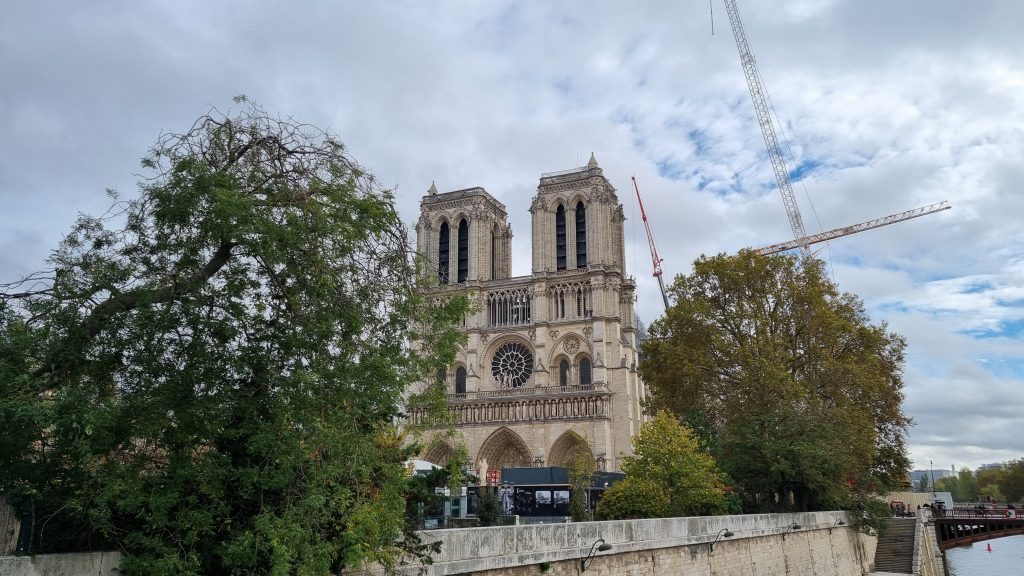
Sights that we had time to see in Paris
Eiffel Tower
It turned out that the famous tower in real life is much larger than we had imagined it to be. We were lucky enough to enjoy its views both in the daytime and the evening, and it has a unique charm at different times of the day. Climbing to the top is not a must; waiting times in queues are long, especially for the descent, and ticket prices are quite high. You can also look at the main symbol of the “city of light” from the side.
Here I share a list of streets with a beautiful view of the Eiffel Tower:
- Rue de l’Université
- Rue de Monttessuy
- Rue Saint-Dominique
- Rue de Buenos Aires
- Pont de Bir-Hakeim
- Av. de Camoens.

Notre Dame
Of course, when visiting the French capital, it is impossible to ignore the Notre Dame Cathedral, one of the most famous symbols of the city and its official center, which was built more than 850 years ago. I, like many others, first learned about it from Victor Hugo’s novel of the same name. By the way, it was only recently that I read that sacred relics, including the crown of thorns, were kept in the temple.
Due to the ongoing reconstruction, we were not able to get inside the cathedral, but we looked at it from all sides externally. Of course, seeing it in person is a real pleasure.


Triumphal Arch
The majestic Arc de Triomphe is a famous architectural monument and a symbol of Paris, located on the Place Charles de Gaulle. And we, of course, did not miss it.
Before heading to this landmark, I learned that the Arc de Triomphe was built to commemorate the fallen soldiers who fought for France during the Glorious Revolution and the Napoleonic Wars. Indeed, the names of 128 battles won by the Republican and Imperial armies and the names of 660 French commanders are engraved on the walls of the Arch.


Pantheon
The Panthéon is a majestic building in the Latin Quarter of Paris. Originally built as a church in the 18th century, it is now a mausoleum in honor of prominent French citizens. The inscription above the entrance reads “Aux grands hommes, la patrie reconnaissante” (“To the Great Men, a Grateful Homeland”).
We were in Rome a few years ago, so in Paris, we immediately noticed the neoclassical design with a facade inspired by the Roman Pantheon. The dome of the Paris Pantheon, by the way, is one of the highest points in Paris and offers a panoramic view of the city. We also learned that the Pantheon hosts temporary art exhibitions, concerts, and conferences throughout the year.
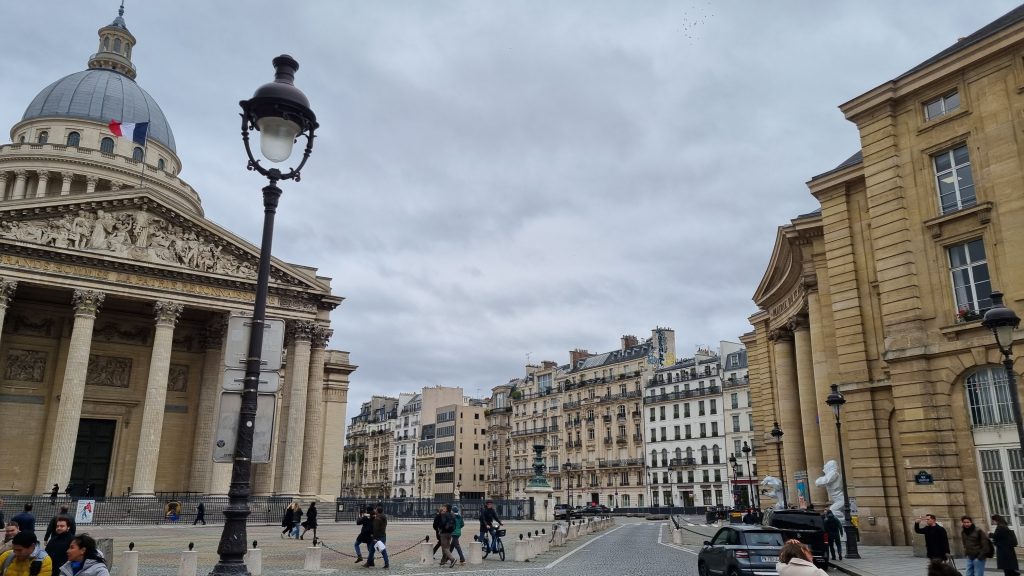
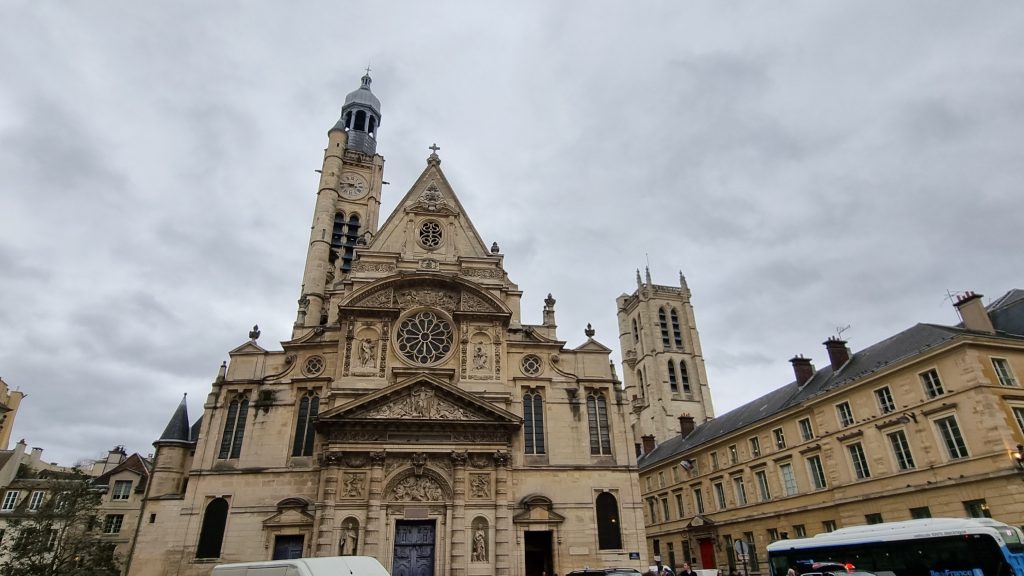
Louvre
We booked tickets to the main museum of the city online on the website, and we advise everyone to do so to have a chance to have a look inside. One more tip from me: before you go, mark the halls you would like to visit so that you can enter from the right entrance, as due to the scale of the building, you may not get to the art objects you are interested in. You can download a map of the halls on the museum’s website.
We were mainly interested in paintings of Italy, France, and Northern Europe, as well as some sculptures. So, we bought audio guides and wandered along the route we were interested in. Of course, we did not miss the famous Mona Lisa as well as the sculpture “Venus of Milos”—the places in the museum where you can meet the most tourists.
My favorites in the museum were the paintings “The Virgin and Child with Saint Anne” by Leonardo da Vinci and “The Money Changer and His Wife” by Quentin Matsys.





Galeries Lafayette
This place, which looks like a palace from the inside, is where all the big and famous brands are concentrated. But there’s one more feature and even a little bit of a trick: you can go up to the roof of the gallery and you’ll get a good view of the city, and it’s free of charge.

Montmartre, Moulin Rouge and Sacré Coeur
A special treat for us was a walk around Montmartre. Here we took pictures in front of the famous Moulin Rouge, saw with our own eyes the pink house, Picasso’s studio, and the Wall of Love, as well as looked from all sides at the beautiful Sacré-Coeur Basilica (which, by the way, also offers an incredible view of Paris).


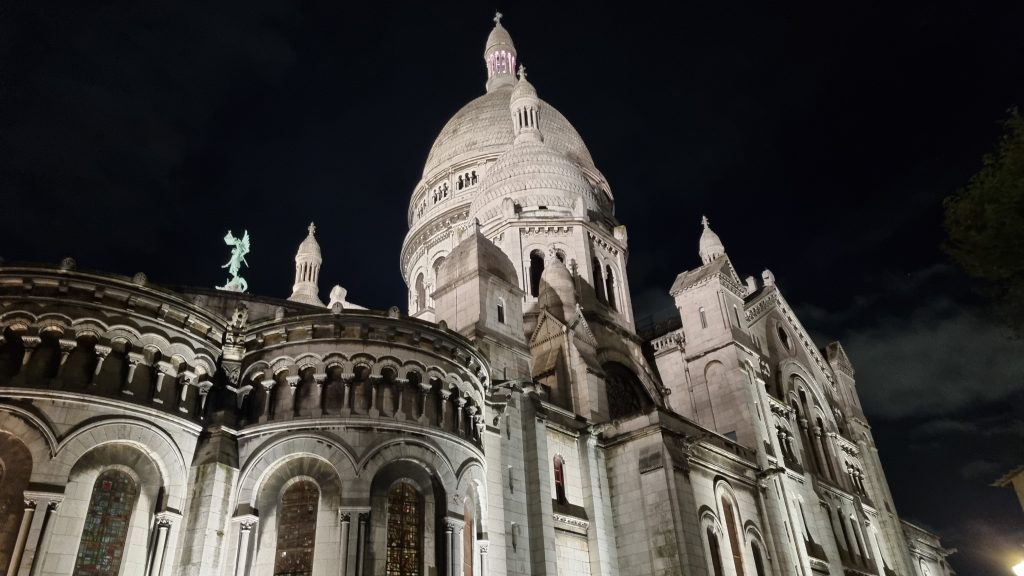
Places in Paris that not everyone knows about
Now I’m going to talk about some very cool spots on the Paris map that aren’t as famous as the previous ones but are worth just as much attention.
St. Chapelle
Sainte-Chapelle is a Catholic cathedral that sits on the Isle of Cité in Paris, directly opposite the Cathedral of Our Lady of Paris. In French, Sainte-Chapelle means “Holy Chapel.”
According to many, in its beauty, it even surpasses the latter; just by coincidence, it remained in its shadow. What is interesting is that St. Chapelle was also built in the 13th century, but it was erected in only 6 years, while the construction of Notre Dame took about 2 centuries.
We were lucky enough to visit this chapel, and it was beautiful. Everything starts with the mesmerizing facade of the building, but when you find yourself inside, you are illuminated with light and such incredible beauty that the impression is just off the scale. In short, I recommend a visit.
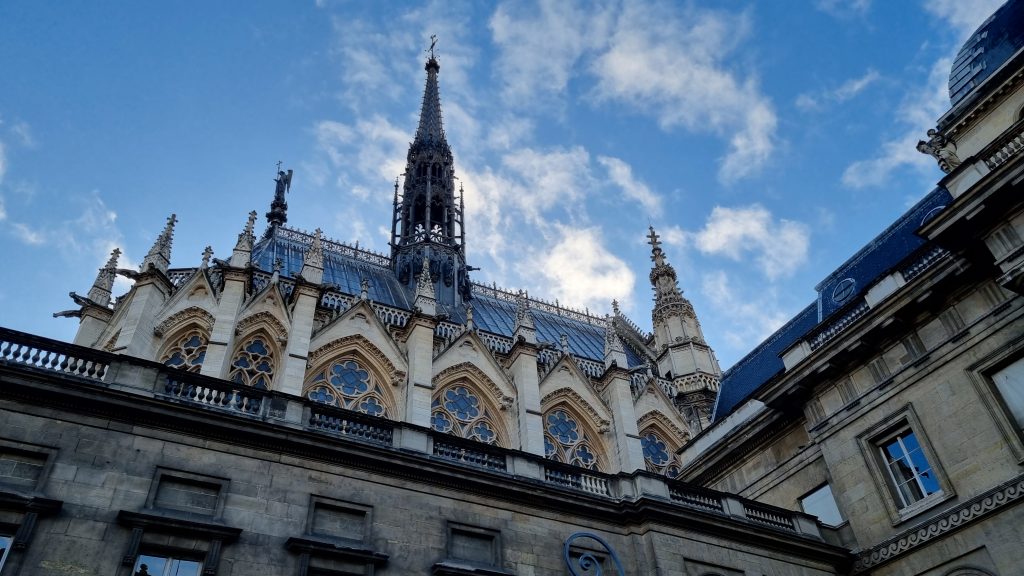


Shakespeare and Company Bookstore
Shakespeare and Company (rue de la Bucherie, 37) is one of the most famous bookstores in the whole world! It has occupied a small house opposite Notre Dame since 1964. All books here are exclusively in English. We did not fail to stop by and stayed there for at least an hour and a half, enjoying the aesthetics and spirit of the place immensely!
Interestingly, Sylvia Beach, who ran the place, first discovered James Joyce’s talent to the world and helped him publish Ulysses. In general, this bookstore was a regular gathering place for creative people whose legacy we now enjoy and benefit from.
Of course, it is impossible to leave this building without books, and I barely stopped to buy three paper editions. By the way, those who wish can go up to the second floor, grab a book from the shelf, and read it surrounded by authentic bookshelves. In short, I recommend this place wholeheartedly.



Orangerie
To teleport from Paris to Giverny for a couple of hours and see Monet’s “Water Lilies,” we stopped by the Musee de l’Orangerie. The museum is located on the banks of the Seine, right in Tuileries Garden, one of the first examples of a French regular park from the 16th century.
To be honest, I liked this museum in some ways even more than the Louvre: in addition to the impressive oval hall with Monet’s paintings, here you can enjoy whole halls with works by Modigliani, Chaïm Soutine, Pierre-Auguste Renoir, etc. You can also stay here for a long time, and on your way back, you can buy some souvenirs in a special shop.





Palais de Tokyo
The Palais de Tokyo is a huge contemporary art space open to the public. It is not actually a palace, but a former exhibition hall built for the 1920s World’s Fair. Since then, it has become a place for all kinds of artistic expression, from paintings and sculptures to performances and installations.

Where we had time to stroll
Paris is not only about the sights but also about the great scenery for walking. For example, we had time to stroll along the shopping galleries on the Champs-Élysées, as well as on the most fashionable street of the city—Saint-Honoré; we also stopped by the Luxembourg Gardens – a great place for an afternoon chill on the background of large flowerbeds and the Palace, where the French Senate sits today. On our last evening in Paris, we strolled through the Marais, a favorite neighborhood of Parisians. There, it’s easy to find the colorful building of the Museum of Modern Art, the Pompidou Center, or otherwise Beaubourg. I have already mentioned the beautiful Montmartre and the Tuileries Gardens.
Speaking of promenades, we can’t help but talk about walking along the Seine River – an experience we also managed to have.
Lifehack: Bateau River streetcars run along the Seine. They make eight stops in the city center (Notre Dame, Louvre, Musée d’Orsay, Eiffel Tower, City Hall, Champs-Élysées, Saint-Germain-des-Prés, and Botanical Gardens). The boats leave every 20–25 minutes from 10:00 to 19:00 in the winter (until 21:00 in the summer). Purchasing tickets online is preferable to purchasing them in person. It is possible to get off at stops and get back with one ticket per day.


What we ate and drank in Paris
Let’s start with my favorite: coffee. Before going to Paris, I saw information everywhere that in the French capital, this drink cannot be prepared and that, in general, it is difficult to find good coffee there. However, during all the days of our stay there, we found coffee houses with good ratings, and the coffee there was quite good. The conclusion from this is this: you should look for a place with a good rating and reviews, and then the chance to find something worthwhile will be much higher. I share these coffee houses: KB CaféShop, Terres de Café, and Base Coffee.
Other traditional Parisian things we tasted were quiche Lorraine, pâtés, oysters, onion soup, macaroons, cheeses, and, of course, wine. We liked the onion soup very much, so I am sharing the place where we tasted it: Le Relais Gascon.





Valuable guidelines for those going to Paris
I’ll share some observations that may be very helpful on the trip:
- Drinking water from springs and fountains on the streets is free, so stock up on an empty bottle. Know that free bread and water must be served in every café, a rule that has been in force throughout France since the time of Napoleon Bonaparte.
- Baguette and croissant, the crunch of French cuisine, should be bought exclusively in bakeries—boulangerie. For cheese (including vegetarian cheese), look for signs fromagerie and, to buy wine, specialized enotecas. Supermarkets such as Carrefour or Franprix are backup tools for urban romance.
- Get your ham and meat from the corner shops too. I would recommend the classic “Paris ham,” Jambon de Paris, a cooked-smoked ham. Because it makes the perfect French snack, jambon-beurre. A kind of sandwich with a thick layer of butter and a sure piece of ham sandwiched in a baguette. The perfect dish—simple and delicious.
- Breakfast in Paris usually starts at 7:30–8:00 and lasts until 10:00 (sometimes 11:00). A traditional French breakfast is always sweet and consists of coffee, a glass of orange juice, a quarter of a baguette with butter and jam, and a croissant.
- Most gastronomic cafés and restaurants are only open for lunch and dinner, which means you can eat there between 12:00 and 14:30 and from about 19:30 to 23:00. The rest of the time, the places are often just closed or only offer drinks. If you don’t have time for lunch before 15:00, you’ll probably have to settle for a sandwich from the neighboring boulangerie. From 16:00 to 18:00 comes l’heure de l’apero (happy hours). At this time, you will be offered apéritifs and special prices for light alcoholic drinks.
- Right at the entrance, the waiter will ask you two standard questions: “How many people are you?” (“Vous etes combien?”) and “Are you here to drink or eat?” (“Boire ou mange?”).
- If you are offered a menu in a dozen different languages, you should expect nothing good from the food here. And if the menu is several dozen pages long and looks more like a book, you can get up and leave. The French are convinced: the more dishes on the menu, the worse their quality (logical, agree!). In some establishments, instead of a menu, they bring you a chalkboard with today’s list of dishes written on it. You’ll have to read the handwriting and use an online translator to understand the contents, but you’ll be rewarded with the finest lunch or dinner.
- As a rule, you have two alternatives: choose “à la carte” (i.e., à la carte) or order a “formule” or “menu.” There are two types of the latter: “Entrée ou Dessert + Plat” (appetizer or dessert + hot dish) and “Entrée + Plat + Dessert” (all three items). Dishes can be selected from a list. Sometimes a cafe offers several formulas, which are differentiated by the list of dishes. The more expensive the menu, the more exquisite and complex the dishes offered. But ordering according to the formula in almost 100% of cases turns out to be more favorable than choosing “à la carte.”
- There is usually no “side dishes” section on a French restaurant menu. A side dish is offered with every dish and is, in fact, an integral part of it. This means that thcafésf has already thought about and decided for you what side dish would go perfectly with that dish. If the proposed side dish is something you don’t eat at all, it’s better to just choose another dish rather than ask to replace the side dish. Such a request can be perceived as a questioning of the chef’s professionalism, especially in gastronomic and haute cuisine restaurants.
- Wine is an indispensable attribute of any meal. The wine list is a separate pride of many establishments. If you are not sure about the choice of wine for the dishes you order, you can always ask for help from the waiter, who will gladly recommend something. If wine is the main purpose of going to a restaurant, it is worth choosing a place that specializes in it. There are restaurants where they will create a cheese plate for the selected wine, which perfectly suits the drink and helps it to open in all its glory.
- If you are ordering wine simply as an accompaniment to dinner and do not expect any frills, you can always order a “pichet,” a jug of 250 to 500 ml. This is a simple table wine or an IGP (protected geographical indication) wine produced in the region.
- In French, a tip is called “pour boire” (“to drink”). They are rarely left here and, as a rule, only for a long dinner with a noisy large group—no more than €1-2, even if the bill is quite impressive. Service is already included in the bill, and waiters in France usually have quite decent salaries.
- Pick up any wine over €5 in the store, and you won’t go wrong. Bad wines are very rare in France. The government strictly monitors the work of wineries and the quality of the beverages produced. If you want something more refined, choose a bottle with a green stamp and the inscription Mis en bouteille en propriété. This means that the wine was bottled where it was made.
In the end, I would like to say that Paris gives the impression of a very lively city, with its flaws and advantages, and with wonderful food, people, and architecture. This vitality of the city and the love of its citizens for life and its manifestations are, in my opinion, the most important advantages of the French capital.



